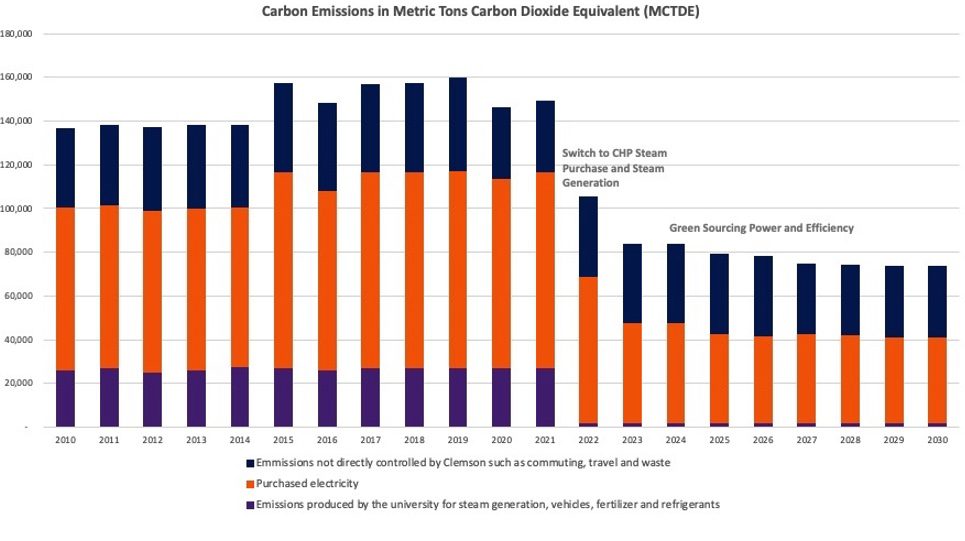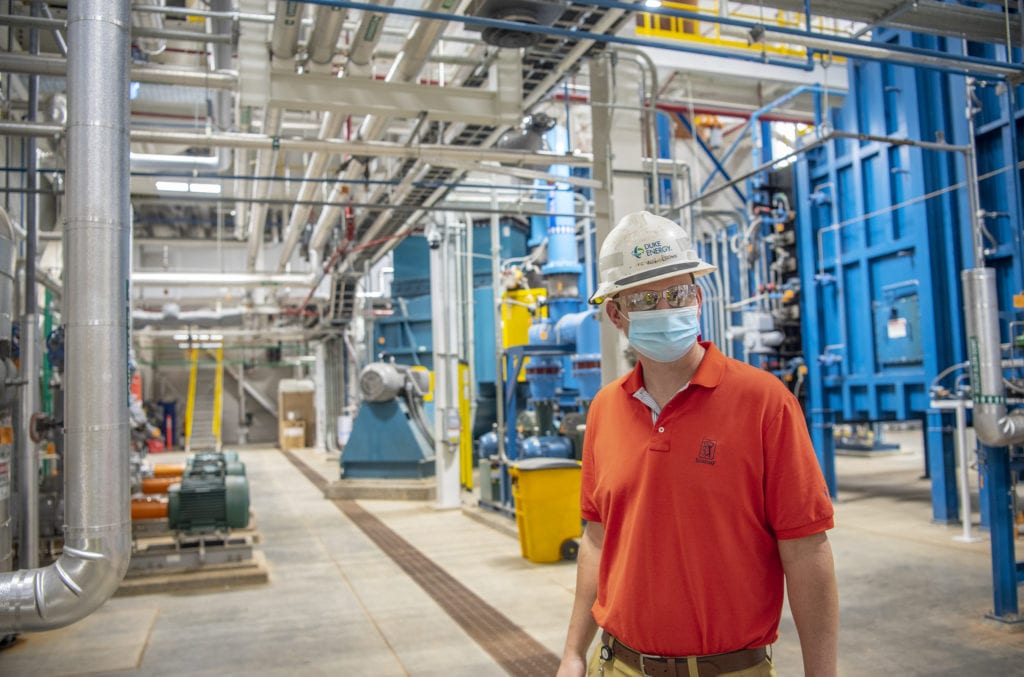As the University moves past the midpoint on its journey to becoming a carbon-neutral campus by 2030 and in honor of Earth Day, April 22, it’s an appropriate time to assess Clemson’s strategy to effectively drive down carbon emissions and to consider what more we can do as individuals and members of the Clemson community.
Fourteen years ago, when 93 percent of Clemson’s students agreed the University must strive to meet the definition of sustainability and 78 percent felt a moral obligation to protect the environment, Clemson University became a charter signatory to the American College and University Presidents’ Climate Commitment, establishing the goal to make its campus a model of energy sustainability and to operate as a carbon neutral campus by 2030.
Being good stewards of the Earth is in the very DNA of Clemson University.

A century and a half earlier, Clemson’s eventual founder, Thomas Green Clemson, shared his assessment that “science is the only foundation on which we can depend for the recuperation of exhausted lands.”
Often, the tendency when managing environmental issues is to start and stop incongruous projects. While even this has its benefits, executing projects with a layered, strategic methodology has a more significant positive impact. When Clemson’s leaders adopted the Sustainability Action Plan 10 years ago, they committed their expert navigation and leadership while adopting the view that the long, sustained journey toward 2030 would have many milestones to celebrate along the way.
The University’s sustainability work is a two-pronged effort to operate its learning, living and working environments in the most efficient way and to graduate environmentally conscious students, some going on to professional work in an array of environmental fields.
Though many academic disciplines can lead to environmental and sustainability careers, according to Clemson University’s Interactive Factbook, graduates earning degrees in Environmental and Natural Resources, Environmental Engineering, Forest Resource Management, Plant and Environmental Sciences, and Soils and Sustainable Crop Systems more than doubled over the past 10 years, rising from 41 during 2010-11 to 97 during 2019-2020.
In terms of its campus environments, the University is following multiple strategic projects to reach its net-zero 2030 goal with contributions from many departments, groups, employees and students. Collectively, projects have reduced costs, increased research into innovative technology and provided real-world learning opportunities.

“Efficiency and operational excellence drive our sustainability efforts and result in optimal teaching, working, living and learning environments. Our efforts to reach carbon-neutrality will have a significant positive environmental impact,” said Tony Wagner, executive vice president for Finance and Operations.
While there are dozens of Clemson projects designed to reduce negative impacts to the environment under way, three projects have been chosen in recognition of Earth Day 2021.
Reducing energy use with green buildings
The South Carolina Energy Office recently recognized the University for achieving a 20 percent reduction in energy use mandated by the state’s Energy Conservation Act. Much of that reduction is due to the construction of energy-efficient buildings, according to Utility Services Director Tony Putnam.
Seven years before adopting the Sustainability Action Plan, the University adopted a Sustainable Building Policy mandating all new buildings meet or exceed the energy efficiency standards required to achieve LEED Silver certification from the U.S. Green Building Council.
Today, 27 Clemson University buildings meet LEED Silver or Gold standards. Four have been awarded Green Globes for meeting an even greater number of standards set by the Green Building Initiative.
Meeting the LEED or Green Globes standards “results in a sustainable, energy-efficient structure with reduced operating costs and it demonstrates our commitment to best practices in sustainable design, construction and operations,” said Tommi Jones, project manager with University Facilities.
The Wilbur O. and Ann Powers College of Business building garnered three Green Globes, the most of any University building. Measuring efficiency and sustainability from 1,000 benchmarks or criteria, Green Globes assesses energy use, the materials used and the quality of the indoor environment.
Architect Cindy Benjamin of LS3P Associates said being aware of Clemson’s goal to meet Green Globes standards at the start of the building’s planning and design stage provided an opportunity for planners to form a checklist of needs to incorporate along with the college’s requirements.
Paul Borick, University Facilities’ project manager, says a major asset is the air-handling equipment controlled by an automated system. Its network of sensors can detect movement and thermal heat so it knows when rooms are occupied and need to have more heated or cooled air and whether lights need to be on or off.
The thermodynamic glazing on south- and west-facing windows automatically darkens in sunlight and can be controlled by computer, reducing incoming solar heat, especially through large windows in the atrium.
Other considerations were the roof, which is white to reflect the sun’s heat, and the big, inviting staircase in the atrium.
The staircase was designed so people would use it instead of opting for elevators. That was a consideration to encourage healthy behavior and reduce electricity used for the elevators, according to Tehmani Husain of Merrick and Company, the project’s sustainability consultants.
“Since we know our capital projects will be certified by either Green Globes or LEED, the entire team works towards that goal,” Jones said. “The intent is to build an energy-efficient building which will conserve energy, use less water and promote sustainable features.”
Clemson Capital Projects Director John McEntire said the University’s buildings need to be designed for 50 or more years of use, so efficiency and sustainability are important.
“I like to think we’re trying to set an example for other state agencies,” he said. “Clemson’s purpose is higher education. We’re teaching future architects and engineers how to design energy-efficient buildings. We’re practicing what we teach.”
Clemson Energy Visualization & Analytics Center
Working remotely since last spring, 10 students with the Clemson Energy Visualization & Analytics Center, or CEVAC, are developing ways to aggregate, analyze and display data about 27 campus buildings’ energy use, air quality and systems.
Drawing from a big database with more than 420 million records, their goal is to help identify areas where Clemson could reduce their carbon footprint by creating dashboards that show how buildings are performing, when systems are working too hard – and using too much energy – and ways to optimize energy use.
Tim Howard, the facility manager at the Watt Family Innovation Center, and David White, research associate for analytics and GIS at the Watt Center, came up with the idea for CEVAC in 2018 when they were talking about the building, which collected data on temperatures, humidity, systems and energy use throughout the building.
“The Watt Innovation Center is meant to be an intelligent building, but we really weren’t doing anything with the data until recently,” Howard said.
Howard and White came up with the SmartWatt idea that displayed the temperature, humidity and carbon dioxide levels in the building. “We presented that to Facilities, and they liked it,” Howard said.
With support from Facilities and the Watt Center, they were able to hire students and began collecting data from other buildings. Howard, White and Snowil Lopes with Facilities oversaw the development of CEVAC.
Today, CEVAC provides the capability to see how much electricity is being used on each floor of the building and how much steam is needed for heat and chilled water for cooling.
Howard said White is working on proposals for machine learning so the building systems would react based on real-time information, ramping up heating or cooling when it’s needed rather than based on planned schedules.
“You go into a room with a group of people,” Howard said. “All of a sudden it gets really stuffy. Well, maybe we’ll do a little bit of active ventilation and it will make it more comfortable for everybody.”
CEVAC students will share more information about their work during a virtual presentation at 9 a.m. April 23. Register here to see the presentation.
Clemson-Duke Combined Heat and Power Plant
The new building at the entrance to the R-1 parking lot off Newman Road may not garner as much attention as a new campus building for classrooms or research. Still, it represents a major step in the University’s journey to reduce its carbon footprint.

Kevin Brown, operations superintendent of the Clemson University Combined Heat and Power Plant for Duke Energy Regulated and Renewable Group proudly walks through the new facility on the Clemson campus. Brown graduated from Clemson in 2010 with a degree in civil engineering.
The Clemson Combined Heat and Power Plant (CHP), constructed with Duke Energy near Kite Hill, will produce steam for power and to provide hot water and heat buildings across campus more efficiently and with lower emissions than the University’s central steam station at the base of the large smokestacks along Klugh Avenue.
In 2011, the University permanently stopped burning coal to produce steam, switching to cleaner natural gas. When the more efficient CHP goes online in the coming weeks, the central steam station will become its backup, said Utility Services’ Putnam.
Inside the CHP, Operations Superintendent Kevin Brown, a Duke employee and 2010 Clemson graduate, explains how it works.
Clean water is pumped into a Heat Recovery Steam Generator where it is heated by a Siemens gas turbine and converted to steam while also producing more than 13 megawatts of electricity.
“The superheated steam enters a boiler, then, at 340 psi, leaves the CHP through a 10-inch pipe to produce campus power and connect with nine miles of insulated pipe under that campus that deliver heat and hot water to buildings and sterilizing steam for research labs.”
Putnam said the electricity produced by the CHP will enter Duke’s electrical grid, but in the event of a general power outage, it can be re-directed to provide electricity to most campus buildings. “We could keep most critical things running,” he said.
Projects like these are either under way or being planned as part of its Sustainability Action Plan. Visit Clemson’s Net-Zero Goal for more information.
Get in touch and we will connect you with the author or another expert.
Or email us at news@clemson.edu

